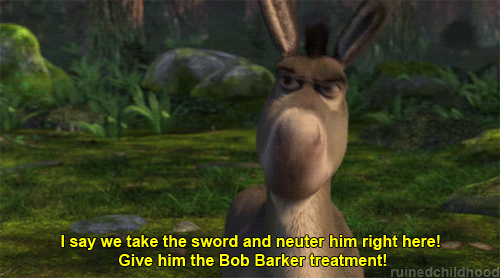Shrek is an animated film that greatly exemplifies
genre-bending, as it exceeds outside the usual boundaries of its genre and
breaks the familiar codes, conventions, and creeds. It brings in elements of
several genres and shatters pre-conceived notions of several types. Shrek is
considered an adventure/comedy movie, however, attributes of other genres, such
as romance, are also included. The first example of how Shrek is a genre-bender is
that in these fairy-tale-like films, the antagonist and protagonist are distinct
and easily recognized and divided at first glance. During the beginning of
films similar to this, the viewer can often easily point out who is the “bad
guy.” This is different, because in the movie Shrek, he himself is portrayed as the
“bad guy,” as he tries to scare everything in his path and villagers are afraid
of him. It isn’t until about 1/6 into the film that viewers realize that he
does in fact have good intentions, and we gradually see more sides of his personality throughout
the film has he is shown to be more and more adventurous, comedic, and even romantic - instead of hostile and frightening (which slightly also brought in a horror aspect). Shrek is also unique in its genre because it includes well-known characters
from other films and stories, and ties them all together in a very random
scenario. This affects the other films that were brought in because it is likely
to change the audiences’ perspective on the other characters’ personalities. We may know what these characters act like from completely separate stories we have heard in the past, but our opinion on them may change when we
watch Shrek. Characters such as Pinocchio are portrayed differently in this
movie than in their original movie, which impact how we remember them from that point on. The
comedic aspects of the film are different because it uses lots of noticeable
examples of dramatic, situation, and verbal irony. Inanimate objects talk,
and animals wear clothes. This may be commonly used in a children’s movies and books,
however, Shrek also directs comedic lines for adult viewers too. When Puss n’
Boots attacks Shrek in the woods, Donkey suggests to give him the “Bob Barker”
treatment, which refers to neutering the cat, (which is an implication that
young audiences wouldn’t understand). Jokes are disguised and implicit, rather than being direct and blunt like most movies that tie-in comedy. Shrek can also be seen as a genre-bender by looking at the romantic aspects of it. In typical romance
movies, both the man and woman are commonly portrayed as attractive, flawless
characters. In Shrek, they are not. As the fairy god mother says, no (popular)
romance story has had an Ogre as the
guy who gets the girl. Not to mention the fact that Fiona is a princess, and
she also just happens to be an ogre at sunset. This greatly strays away from
typical princess stories because the concept of this spell is so outside of the
box and unique, which differs it from other fairy tales. It shows exceeding flaws and blemishes in each of the characters' personalities and physicality, The greatest proof of
Shrek being a genre-bender is that the characters are portrayed as imperfect,
but they still manage to live happily ever after.

No comments:
Post a Comment